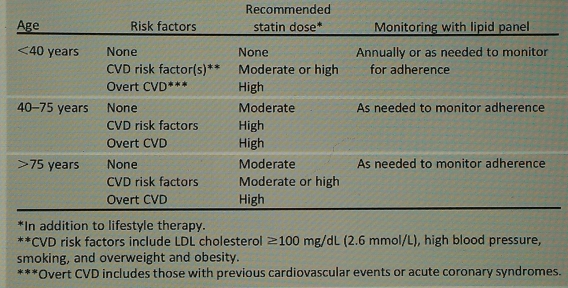American College of Cardiology (ACC) and American Heart Asscociation (AHA) collaboratively published new guidelines and changed certain recommendations for the management of cardio vascular (CV) risks by the help of statins, for a broad range of diabetic patients. As the chances of stroke and heart attack sky rockets with diabetes, American Diabetes Association (ADA) has given an official status to these recommendations.
Now & Then: in old times, sugar was thought to be a culprit in taking lives of diabetics, but now it is known that the leading cause of mortality in diabetes is the heart problems.Diabetic patients are at much higher risks of suffering from a heart attack or stroke than non diabetic patients.
ADA on statins: ADA is now recommending the initiation of high or moderate doses of statins in all diabetic patients for the management of CV risks.
Comparison between old & new diabetes care guidelines on lipid management:
- Screening:
- 2013 guidelines… adult patients with diabetes require to have their fasting lipid profile tested annually. And adults presenting lower values of lipid i.e. LDL cholesterol <100mg/dL, HDL cholesterol 750mg/dL and triglycerides <150mg/dL, lipid profiling can be done after every 2 years.
- 2015 guidelines: its better to have a lipid profile screening conducted at the period of first diagnosis, when the initial medical/clinical assessment is carried out.
2. Treatment recommendations & goals:
- 2013 guidelines… a) adapting new lifestyle choices and modifying eating habits to reduce saturated fat, cholesterol intake and trans fat is required.
b) to ameliorate the lipid profile in diabetics, n-3 fatty acids are to be increased. Physical activity is fully crucial & addition of plant sterols and viscous fibres serves as a better option.
c) Statin use in diabetics with overt CVD or without CVD but above 40 and presenting with one or more of the CVD risk factors such as smoking, hypertension, dyslipidemia, despite of the baseline lipid levels should be included in the life style therapy.
d)in patients with lower risk levels but having LDL above 100mg/dL, statin therapy can be considered along with the lifestyle therapy.
e) LDL cholesterol levels in non overt CVD patients should be along the lines of <100mg/dL and in overt CVD indviduals it should be maintained at <70mg/dL and this can be executed by the use of high doses of statin drugs.
f) combination therapy on comparison with statin alone therapy has not been successful in providing any extra benefits and is not recommended.
g) use of statins in pregnancy is contraindicated.
- 2015 guidelines: a) adapting new lifestyle choices and modifying eating habits to reduce saturated fat, cholesterol intake and trans fat is required.
b) to ameliorate the lipid profile in diabetics, n-3 fatty acids are to be increased. Physical activity is fully crucial & addition of plant sterols and viscous fibres serves as a better option.
c) patients having triglyceride levels higher than 150mg/dL & level of HDL lower than 40mg/dL in men and <50mg/dL in women… the lifestyle modifications, positive choices and lifestyle habits need a boost up.
d) as other reasons can also play a role in bringing about such conditions, so the secondary causes should be assessed and as the risks of pancreatitis elevates in such scenarios, the medication therapy for its prevention and control should be considered.
e)patients irrespective of age suffering from diabetes and overt CVD need to be placed on high intensity statin treatment in addition to lifestyle therapy. Patients younger than 40 years but presentimg CVD risks require moderate or high intensity statin therapy along with the life style modifications.
f) adjustments in the use of statins can be done and it will depend upon the every patients own response to the effectiveness of treatment, side effects, LDL cholesterol levels and tolerability.
g) combination therapy on comparison with statin alone therapy has not been successful in providing any extra benefits and is not recommended.
h) lab test results help in giving a picture of to what extent the treatment is working and how much the patient is following and adhering to his/her therapeutic regimen.
i) use of statins in pregnancy is contraindicated.
Study trials showing positive results with statin therapy in diabetes: type 2 diabetics are more susceptible to develop abnormal lipid levels and to suffer from increased CVD risks. Trials conducted in 36,37 diabetic patients demonstrated a remarkable reduction in CVD events and deaths.
A meta analysis incorporating data from 18,000 diabetic patients on statins ( mean follow up of 4.3 years) showed a 13% reduction in vascular mortality and 9% decrease in all cause mortality.
Researches has shown that statins use in every 1,000 patients is helpful in reducing and preventing 4 strokes, 7 nonfatal heart attacks, 2 deaths.
Why Statin combination therapies were not a success?
- Statin & Niacin: trial conducted on this combination was terminated in the middle due to the lack of the treatment’s efficacy and because of the increase in the rate of ischemic strokes. This combo not recommended.
- Statin & Fibrate: the use of fibrates (e.g. fenofibrate/gemfibrozil) with statins can increase the risks of myositis, rhabdomyolysis, abnormal transaminase levels. Here the side effects or risks outweigh and owerpower the benefits.
According to Richard W. Grant MD at Kaiser Permanent Division of Research, the patients risk profiles and levels can now be used to decide whether to start at a moderate intensity or high intensity statin doses. He also mentioned that not all diabetic patients are in a need of vigorous statin treatment, these patients include young healthier patients and very old patients with other associated medical/health problems and are on poly pharmacy that could shorten their life expectancy.
Reference:
- Diabetes Care Vol. 38, Supplement 1 January 2015.
- Diabetes Care Vol. 36, Supplement 1 January 2013.
- US Pharmacist January 2015.

good guide for us Here is another Guide- tr.im/stopdiabetes
LikeLike
Excellent Informative work.
LikeLike